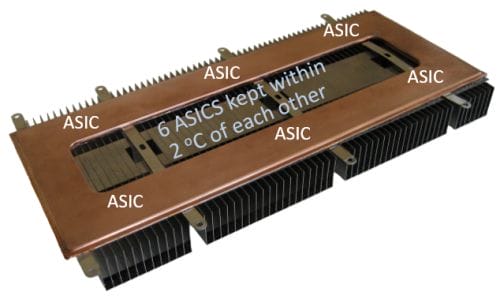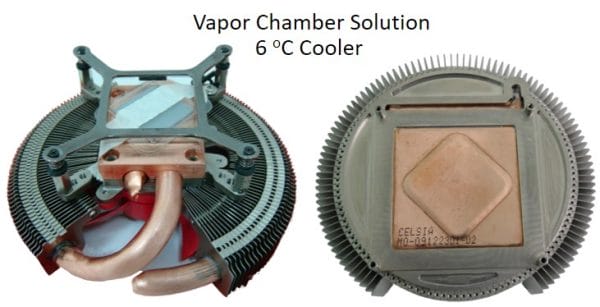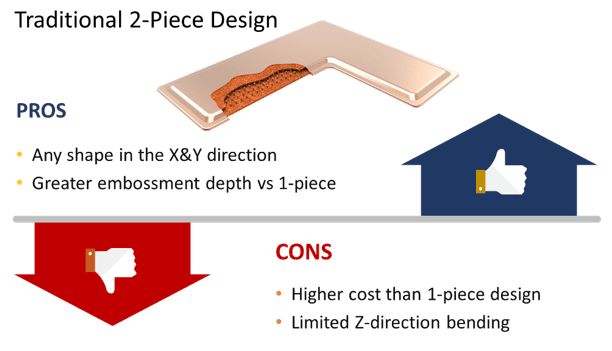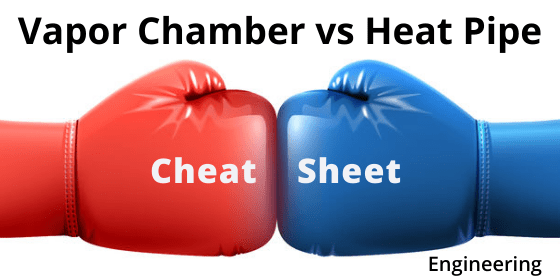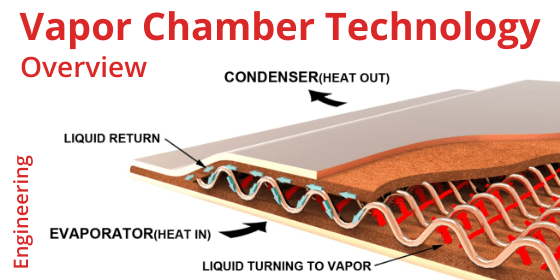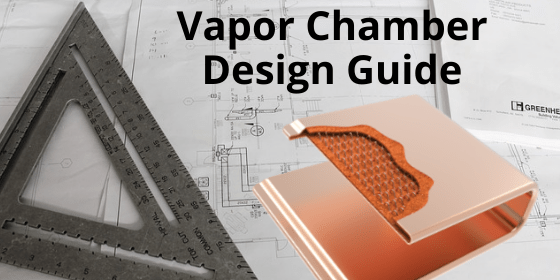Vapor Chamber | Heatpipe Alternative

A vapor chamber is an effective heatpipe alternative that boosts heat sink performance by 5-10 oC for typical electronics cooling applications. Vapor chambers are a simple, relatively cost-effective, and very dependable device that can be used alone or in combination with heatpipes.
Vapor chambers operate under the same working principles as a heatpipe. They have a metal enclosure which is vacuum-sealed, an internal wick structure attached to the inside walls, and move liquid around the system using capillary action. Unlike heatpipes, vapor chambers can achieve an impressive 60:1 width to height aspect ratio (flattened heat pipes are on the order of 4:1).
Let’s take a look at the conditions most likely to result in vapor chambers becoming the best solution versus heatpipes or solid metal solutions.
Vapor Chambers When the Thermal Budget is Very Tight
Heatpipes become a likely solution when the thermal budget is less than 40 oC, but as this budget shrinks vapor chambers become the likely hero. The main reason? Vapor chambers make direct contact with the heat source while heatpipes generally have a base plate between them and the heat source.
Note: thermal budget is the difference between the maximum semiconductor temperature (Max Tcase or Tjunction) and the maximum operating ambient temperature of the final system (Max Ambient).
And yes, you are correct that a heat source can make direct contact with a heat pipe solution. Two issues:
- The heatpipes have to be fly cut, adding an additional step and expense to the solution.
- The mounting block still has solid metal channels between the pipes, reducing thermal performance and possibly creating die face hot spots.
Vapor Chambers When You Need to “Isothermalize”
Vapor chambers are ideal for applications where high power densities need to be dispersed quickly, hot spots across the die face need to be minimized, or 2+ heat sources are required to be close in temperature. Below, 6 ASICS were required to remain within 2 oC of each other. The center cutout reduced weight.
When the goal is to achieve as uniform a temperature as possible, vapor chambers trump heatpipes by virtue of their large contiguous surface area that move heat in every direction. Heatpipes only move heat in a linear direction.
Vapor Chambers When Heat Sink Height is Constrained, Yet Fin Area Needs to Grow
Typically, heatpipes run through the center of a fin stack in order to maximize contact area and therefore transfer as much heat to the fins as possible. The downside – fin area is reduced. While this is not a problem if you’ve got the room to increase fin height, it poses a problem when that metric is constrained, as it is here in an add-in desktop graphics card application. A vapor chamber cooling design frees up needed fin area and provided direct contact to the heat source resulting in a 6 degree performance gain.
Vapor Chamber Conclusion
As mentioned in the opening to this article, heat sink performance improvement of 5-10 oC can be had by using a vapor chamber in place of heatpipes because they make direct contact with the heat source, can more evenly distribute heat across a large base, and allow for maximum fin area.
At Celsia, most of the applications for which we design benefit more from heatpipes than a vapor chamber, albeit those with application-driven changes to wick thickness and porosity to boost performance. But, that’s not to say we aren’t deeply invested in vapor chamber technology. The inherent performance benefits of these devices have been known since the 1960’s.
Vapor chamber cost relative to heat pipes, until a decade ago, was prohibitive for all but the most critical applications. Fortunately, the growing use of these devices coupled with innovative manufacturing techniques pioneered by us a decade ago (1-Piece Vapor Chamber) have driven the price down to near parity with 2-4 heat pipes. Below is a brief summary of the pros and cons of both types of vapor chambers, but more detail can be found here.
Celsia is a custom heat sink manufacturer using vapor chamber and heat pipe technology. We specialize in: heat sink design, heat sink proto, heat sink manufacturing, heat pipes, vapor chambers, custom heat pipe wick materials.



